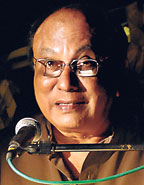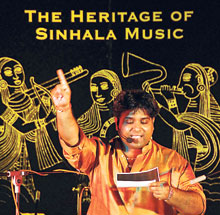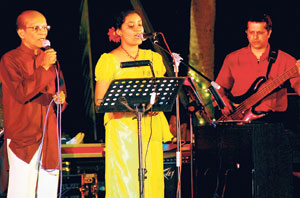| The Heritage Trust of Sri Lanka, founded in 2005 to “safeguard the tangible and intangible heritage of Sri Lanka”, presented a lecture demonstration, by Dr. Tissa Abeysekara on the “Origins of Popular Sinhala Music”.
Dr. Abeysekara himself needs no introduction, having excelled in various aspects of literature and the Arts from Sinhala script writer to English novelist, and many other accomplishments in between.
The lecture was well illustrated with performances by Harsha Makalanda, Ravibandhu, Jannanath Warakagoda, the Ladies’ College choir and other artistes.
In “tracing the bloodlines of Sinhala music”, Dr. Abeysekara took us on an intellectually stimulating musical journey, via pel kavi, bhajans, hymns, nadagam, liturgical chants, Rabindra Sangeet, and the compositions of C. Don Bastian, Fr. Giacomo Gonzalvez, Prof. Ediriweera Sarathchandra, John de Silva, Devar Surya Sena, Sunil Shantha, C. T. Fernando and others, over the years, to Harsha Makalanda and Ravibandhu Vidhyapathi of today.
There were so many aspects and anecdotes relating to our musical heritage, which speaking for myself, I knew nothing about. I had always wondered about the origins of the vannams in Kandyan Dance and on Friday evening, my question was finally answered.
Dr. Abeysekara chose to open his lecture with a rendering of the most basic sound of the human voice in the cadence of the “Andhaheraya”, the villager summoning people to the harvest.
Having been fortunate enough to have spent my childhood in close proximity to villages, fields, tanks and jungles in Sri Lanka, I found that vocalization, instantly wafting me away from the buzz of the city to the calm and peace of a remote, moonlit paddy field, as did the haunting Pel Kavi that followed.
 |
| Tissa Abeysekara |
What Dr. Abeysekara introduced as an “Overture”, took us from tranquility to excitement, from village to city. It was in fact a medley of musical sounds, with percussion predominating, and the melodic strain of the Gajaga Vannama holding it together. Ravibandhu on the Geta Beraya and Jannnanath Warakagoda on the Tammetama in an exciting drum duet, were accompanied by Harsha Makalanda on keyboards, further embellished by other instruments from both Eastern and Western traditions. Audience applause proved the popularity of this piece of fusion music.
Also much appreciated, was the jazz improvisation, of the familiar song “Sriya Mana Math Vee Mage” from the John de Silva play “Ramayana”. Both Ravibandhu, who provided the percussion, and Harsha who improvised on the keyboards were in their element, and had the audience toe tapping to complex rhythms and complicated melodic variations. I wondered whether Makalandage John de Silva would be looking down amazed, at what his great-grandson could do with his song, a 100 years on.
Very different, and most touching was the nostalgic, “Song of the Kelani Boatmen”, which eventually flowed into the beautiful modern composition of “Mahiyangane”, composed by Sarath Fernando and sung by Jannanath Warakagoda.
This review would be incomplete without a comment on the indigenous Ceylon Liturgy, composed in a three day long thunderstorm by Devar Surya Sena, who took as his inspiration, the Gajaga Vannama, the Song of the Kelani Boatmen and other folk rhythms and melodies. The Ladies’ College Choir sang this selection of sacred music. Unfortunately the sound system was inadequate for that many voices. At the back of the hall, some sections of the choir were virtually inaudible, resulting in this rendering, losing the impact it should have had.
In conclusion, I would like to thank Dr. Abeysekara for an enlightening and entertaining evening, and although the humidity was almost intolerable, the two and a half hour long programme had much to interest and educate those who were interested.
 |
| Jannanath Warakagoda |
I wish The National Trust had given more publicity to this lecture, as there were many I talked to subsequently, who knew nothing about the event, and who would have attended had they known.
Now that this commendable National Trust has been established, and has progressed, it is essential that more members of the younger generation be motivated and encouraged to hold office and take responsibility to carry on the good work.
Our national heritage is the heritage of each and every one of us Sri Lankans. It is only with greater publicity and greater involvement of young professionals in every field of learning, and every aspect of society can the ultimate safeguarding of this, our valuable heritage be assured. |



